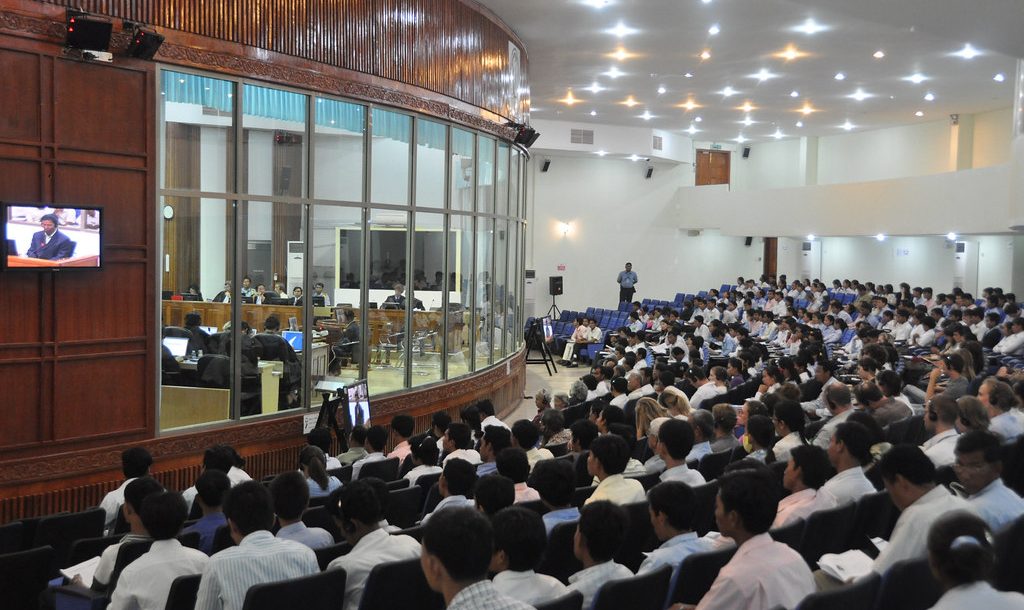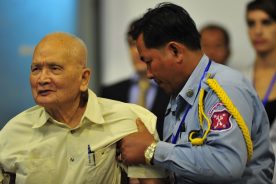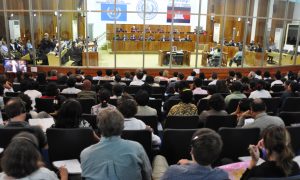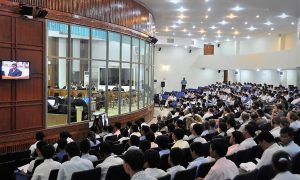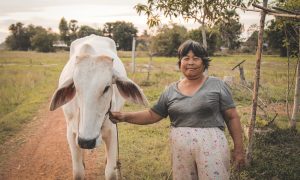It is 42 years already since the fall of the Khmer Rouge regime!
45 years ago, on 17 April 1975, the Khmer Rouge (KR) regime took power, lasting until 6 January 1979. At least 1.7 million people are believed to have died from starvation, torture, execution and forced labor over those three years, 8 months, and 20 days. In order to find justice and reconciliation for the victims, The Extraordinary Chamber in the Courts of Cambodia (ECCC) began in 2006, after 9 years of negotiations between the Royal Government of Cambodia and the United Nations. The role is to prosecute senior leaders and those most responsible for crimes committed during the KR regime.
Four primary cases have been investigated at the ECCC since it began, with some divided into parts. At the time of writing, Case 001, Case 002/1 have passed final verdicts, Case 002/2 is under appeal and some are ongoing.
Outreach programs in Transitional Justice
It is around 10 years since the ECCC in Cambodia began hearing its first case. At the beginning of proceedings, updated information is shared by the ECCC with NGOs in Cambodia through outreach programs, so that updates on each case reached people living in remote areas. Outreach platforms used different methods but very often they included the voice of victims. Survivors shared their experiences in the KR regime at the ECCC or NGO-led forums, regardless of whether they are Vietnamese, Cham or Khmer. Some outreach programs include documentary short films or television programs on the KR regimes.
As the court is located in Cambodia, members of the broader public are able to attend proceedings. Based on Public Affairs Outreach Figures 2009 to 2017, there have been 55,129 participants so far in programs run by the court, including court visits, study tours, and 98,230 students attending school lectures.
The ECCC is the first international court in which victims have had the opportunity to participate in the process of procedure. In the Internal Rules of the ECCC, victims are able to file complaints before the ECCC, and they can be recognized as a Civil Party if they suffered harm during the regime.
From my observations, while survivors often become emotional when speaking about the past, they also feel that younger generations need to know and learn from the past to prevent genocide in future.
In the “Justice and Reconciliation for the Victims of the Khmer Rouge?” report, a survivor said : “I feel believed as I was given a chance to give testimony about what I have been through during a very cruel regime, I feel relieved that I can show the younger generation they must not allow this type of regime to happen again.”
The survivors are witness who can tell the youth that this regime happened, even if they don’t know much about the structure at the top levels or the overall strategy of the regime. They can at least describe their experiences and how they suffered. In this way, it is a supplement to the ECCC’s findings.
After many years working in this field, I am used to hearing the opinion from survivors that their children do not believe them because, they say, “Khmer could not kill Khmer.” During outreach programs and discussions, the question often is raised: “why did they killed Khmers? Why do they need to force people to work hard? Why did they have to evacuate people from one place to another?” Thus, the young people need to gain understanding and to hear more about what happened during this regime from different perspectives. However, although 45 years has passed since this regime began, it can still be hard for survivors to break their silence. It remains hard to recall the past.
In our interview with Soeung Phearak, a media reporter, he said “I used to hear about the Tribunal [the ECCC] from the television or radio but I never heard what my mum faced during the Khmer Rouge regime. I really want to hear what my mum suffered during the Khmer Rouge regime, but she always skipped over what happened…She is the most important evidence of what she suffered.”
How the ECCC contribute to the history education in formal education?
Article 65 of the Cambodian Constitution, in the chapter on Education, Culture and Social Affairs, declares that the state shall “promote the right of the citizen to a quality education at all levels and shall take every measure to progressively make this education available to all the citizens.”
The history of Khmer Rouge regime is delivered in the existing curriculum in high schools. As the textbook was created prior to the beginning of public hearings, it does not currently include any information taken from the tribunal.
In order to promote the history of Cambodia during the Khmer Rouge regime, a reparations project was included in the judgement of Case 002/1, which proposed the “inclusion of a chapter on forced population movement and executions at Tuol Po Chrey within the Cambodian school curriculum”. Since this curriculum update is on-going it is supplemented by Documentation Center of Cambodia Programs (DC-Cam). DC-Cam, which has compiled a history textbook, teachers’ guide book and other materials for lecturers in order to transfer knowledge to students across Cambodia.
The ECCC process in each case is slow and thorough, from the investigation process through to the verdict. Thus, the materials or evidence used during proceedings and written in those judgements is often extensive. In the Pre-Trial Chamber approximately 1,000 documents in Khmer French and English were put before the Chamber and subject to examination. It was no different in Case 002/01, with approximately 5,824 pieces of documentary evidence include documents, audio and video recording and written evidence witnesses, experts and Civil Parties. In Case 002/02, the documents subject to examination stretched to over 82,000 pages. These sources will be contained in archives like the Legal Documentation Centre, DC-Cam and Bophana Center, so that future generations and members of the public are able to access them.
On the topic of how of the ECCC passes knowledge to the youth, there are different opinions. Youk Chhang, director of the Documentation Center of Cambodia, was quoted in the Phnom Penh Post in 2018. “The ECCC is a court of law, not a history department,” he said, saying that seeing the tribunal as a teaching tool “completely undermines” the years and millions invested in it. “Its legacy is justice… to prosecute the Khmer Rouge leaders.”
By contrast, Keo Duong, a history lecturer and member of the committee revising the text-book for formal education, explains that:
“Decisions in the judgement are based on multiple sources and evidence in order to make a careful conclusions. It is a solid reference for Cambodian history and of course, formal education. I’m now a member of history textbook writing committee. I write about history for formal education and one of the sources I use is ECCC sources and judgements. For example, the lesson on S-21, the number of people who were at S-21, the crimes committed by top leaders, reports or primary sources that have been used in the court and so on.”
Conclusion
We urge the Ministry of Education and the relevant departments to include information from the ECCC and the existing curriculum as soon as possible, and to teach this in a critical way, so as not only to remember but also to understand.
Brother No. 2 of the Khmer Rouge becomes a lesson learned at the ECCC?
The recent death of Nuon Chea has left the people of Cambodia with more questions about the Khmer Rouge regime and if they will ever be given justice.
As the ECCC winds down its operations, its outreach programs should continue in some form, as they are an efficient method with which younger generations can be in dialogue generations who experienced the KR regime, to ensure these crimes don’t happen again.
Within the family, older people should be encouraged to talk more openly about the KR regime, because their experiences are testimony to what happened during the KR regime. Young people should make the most of speaking to this generation, which is growing old now. Their evidence should not go to the grave with them.
I would like to thank for Caitlin McCaffrie for editing this article from the first version until the outcome.
 Facebook
Facebook  Twitter
Twitter  Soundcloud
Soundcloud  Youtube
Youtube  Rss
Rss 